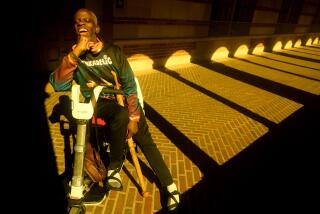Volunteer Program : Heads Up Gets Handicapped Back in Saddle
- Share via
Ken Guyot can’t walk, but, boy, can he ride. And not just in a wheelchair.
Guyot, 23, was an athletic young Canyon Country man when he was struck by the car that robbed him of his ability to walk and to talk clearly. No one dreamed he would ever emerge from a two-month coma, his parents said, never mind be able to mount a large horse and ride it around the ring at the Los Angeles Equestrian Center in Burbank on Sunday.
The occasion was a benefit for Heads Up, a nonprofit, therapeutic riding program based in Saugus that has given Guyot and dozens of other disabled adults and children something to live for.
“I want to start jumping next,” said Guyot, who was 19 when his disabling accident occurred.
In Need of Help
Nancy Pitchford, founder of the three-year-old program that relies on volunteer riding instructors and donations, said she believes in Guyot and all her students, some of whom are mentally retarded, arthritic or blind.
But at $1,000 per month in horse feed and shelter alone, she said she needs some help from the community to keep the program alive.
Help materialized Sunday during the benefit sponsored by Newhall Trail Riders, an organization of equestrians. The group raised about $10,000, selling more than 2,000 raffle tickets at a $1 each and auctioning off the breeding services of some 50 purebred stallions, including Tennessee Walkers, Arabians, Appaloosas and miniature Pintos.
Thirty celebrities, including Kenny Rogers and Bob Hope, donated less-horsy auction items, such as autographed scripts and clothing.
“At this rate, we’ll have Ken jumping,” Pitchford said. “There’s never been a rider we haven’t been able to work with.”
‘Bawled Like a Baby’
Pauline Franklin of North Hollywood had her doubts when her family doctor first recommended the program six months ago. Her 21-year-old son David functions at the level of a 2-year-old, is blind and cannot walk because of severe curvature of the spine. But now he can ride, thanks to the program.
“The first time he was in a show, I bawled like a baby,” Franklin said. “When the audience applauded, he straightened up his back, and I thought, ‘He can do something, he can do something.’ ”
Pitchford said the key to working with David was to establish a rapport with him. She and her 15 volunteers team up in groups of three to give each student personal attention during the 45-minute lessons. Their youngest rider is an 18-month boy with cerebral palsy who rides lying down on his stomach.
“The body warmth of the horse stimulates circulation and the movement of the animal tones muscles,” Pitchford said. “The biggest kick the kids get, though, is to be sitting on this big animal and controlling it. For them, to be mobile and independent is the greatest self-esteem raiser.”
Pitchford is speaking from experience. Depressed after her first marriage ended more than three years ago, she turned to riding for solace. Shortly thereafter, she began teaching deaf children to ride in her spare time from her job as a personnel manager. Her first blind student became her second husband.
“Riding has done so much for me, I just wanted to share it,” Pitchford said.
More to Read
Sign up for Essential California
The most important California stories and recommendations in your inbox every morning.
You may occasionally receive promotional content from the Los Angeles Times.













